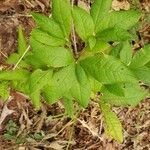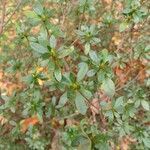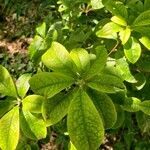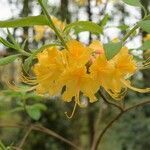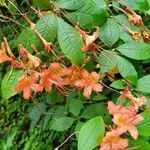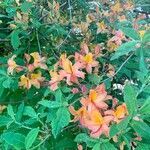Shrubs or trees, to 4(-10) m, usually not rhizomatous. Stems: bark smooth to vertically furrowed, shredding; twigs sparsely to conspicuously multicellular eglandular-hairy (hairs unbranched), otherwise sparsely to moderately unicellular-hairy. Leaves deciduous; petiole multicellular eglandular-hairy and unicellular-hairy; blade ovate to obovate, 4.5-9.1 × 1.3-3.3 cm, thin, membranous to chartaceous, margins entire, plane, ciliate, eglandular-hairy, apex acute to obtuse, often mucronate, abaxial surface glabrous or densely eglandular-hairy, often also very sparsely to moderately unicellular-hairy, adaxial surface glabrous or sparsely scattered eglandular-hairy, often also sparsely unicellular-hairy. Floral bud scales usually glabrous abaxially, margins glandular. Inflorescences 5-9-flowered; bracts similar to bud scales. Pedicels 7-14 mm, stipitate-glandular-hairy and/or eglandular-hairy, otherwise sparsely to densely unicellular-hairy. Flowers opening before or as leaves expand, erect to horizontal, acrid-scented; calyx lobes 1-3 mm, scattered usually stipitate-glandular-hairy and unicellular-hairy, margins long stipitate-glandular-hairy and/or eglandular-hairy; corolla orange to red-orange, with contrasting, darker-colored, orange to yellow blotch on upper lobe, funnelform, 30-54 mm, densely multicellular stipitate-glandular-hairy, otherwise sparsely to densely unicellular-hairy on outer surface, petals connate, lobes 14-30 mm, (spreading nearly as broadly as tube is long), tube abruptly expanding into lobes, 16-28 mm (longer than lobes); stamens 5, much exserted, ± unequal, 52-72 mm. Capsules borne on erect pedicels, 15-29 × 5-9 mm, sparsely to moderately long stipitate-glandular-hairy and/or eglandular-hairy, and sparsely unicellular-hairy. Seeds without distinct tails, flattened portion of testa well developed at each end; testa expanded, dorsiventrally flattened, ± loose. 2n = 52.
More
Much branched upright shrub to 3 m, not colonial; lvs oblong to obovate or oblanceolate, not yet full-grown at anthesis, later 5–10 cm, half as wide; winter-buds glabrous; fls in clusters of 5–15, scarcely fragrant, yellow to orange and red, 4–5 cm wide, the tube usually glandular-setose; upper lobe of the cor only slightly wider than the others; sep oblong-ovate, glandular-ciliate, 2–3 mm; 2n=52. Mt. woods; Pa. and s. O. to Ga. and Ala. May. (Azalea c.) South of our range enters into a polyploid complex with no. 12 [Rhododendron bakeri (W. P. Lemmon & McKay) H. H. Hume].
